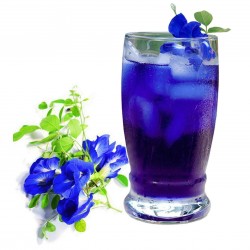- -15%












Clitoria ternatea, commonly known as Asian pigeonwings, bluebellvine, blue pea, butterfly pea, cordofan pea and Darwin pea, is a plant species belonging to the Fabaceae family. The flowers of this vine have the shape of human female genitals, hence the Latin name of the genus "Clitoria", from "clitoris". (Synonyms: Clitoris principissae.)
This plant is native to tropical equatorial Asia (Indonesia and Malaysia), but has been introduced to Africa, Australia and America.
It is a perennial herbaceous plant, with elliptic, obtuse leaves. It grows as a vine or creeper, doing well in moist, neutral soil. The most striking feature about this plant is the color of its flowers, a vivid deep blue; solitary, with light yellow markings. They are about 4 cm (1.6 in) long by 3 cm (1.2 in) wide. Some varieties yield white flowers.
The fruits are 5–7 cm (2.0–2.8 in) long, flat pods with six to ten seeds in each pod. They are edible when tender.
It is grown as an ornamental plant and as a revegetation species (e.g., in coal mines in Australia), requiring little care when cultivated. As a legume, its roots form a symbiotic association with soil bacteria known as rhizobia, which transform atmospheric N2 into a plant-usable form, therefore, this plant is also used to improve soil quality through the decomposition of nitrogen rich plant material.
In Southeast Asia the flower is used as a natural food colouring. In Malay cooking, an aqueous extract is used to colour glutinous rice for kuih ketan (also known as pulut tai tai or pulut tekan in Peranakan/Nyonya cooking) and in nyonya chang. In Kelantan, east part of Malaysia, by adding a few buds of this flower in a pot while cooking white rice will add bluish tint on the rice which is served with other side dishes and such meal is called nasi kerabu. In Thailand, a syrupy blue drink is made called nam dok anchan (น้ำดอกอัญชัน), it is sometimes consumed with a drop of sweet lime juice to increase acidity and turn the juice into pink-purple. In Burmese and Thai cuisines, the flowers are also dipped in batter and fried. Butterfly pea flower tea is made from the ternatea flowers and dried lemongrass and changes color depending on what is added to the liquid, with lemon juice turning it purple.
In traditional Ayurvedic medicine, it is ascribed various qualities including memory enhancing, nootropic, antistress, anxiolytic, antidepressant, anticonvulsant, tranquilizing, and sedative properties. In traditional Chinese medicine, due to its appearance similar to the female reproductive organ, and consistent with the Western concept of the doctrine of signatures, the plant has been ascribed properties affecting this organ.
Chemical constituents
Chemical compounds isolated from C. ternatea include various triterpenoids, flavonol glycosides, anthocyanins and steroids. Peptides known as cliotides have been isolated from the heat-stable fraction of C. ternatea extract.
Unfortunately, Butterfly Pea plants are only hardy in USDA zones 10-11, but because they are such fast growers they are often grown as an annual plant in colder regions.
Butterfly Peas prefer to be grown in full sun but they will tolerate light shade.
These are very drought tolerant plants, but they should be watered regularly for the best results.
Never over water Butterfly Peas!
Pinch regularly to induce bushiness.
Butterfly Pea seed pods are edible and tasty.
The seeds of the Butterfly Pea should be nicked or filed, then soaked overnight in room temperature water before planting.
They can be sown directly in the garden with 3-4 inch spacing when the soil warms in the spring.
Start seeds indoors 12 weeks before the warm weather arrives, maintaining a temperature within the growing medium of 70°-75° F.
Germination takes 15-20 days.
Sowing Instructions |
|
|
Propagation: |
Seeds |
|
Pretreat: |
Carefully scarify seeds with a knife, or roughen with sandpaper. Then soak in warm water for 12 h. |
|
Stratification: |
0 |
|
Sowing Time: |
all year round |
|
Sowing Depth: |
0,5 cm |
|
Sowing Mix: |
Coir or sowing mix + sand or perlite |
|
Germination temperature: |
25-28°C |
|
Location: |
bright + keep constantly moist, but not wet! |
|
Germination Time: |
3-6 weeks |
|
Watering: |
in the growing season moderate water + let dry between watering |
|
|
Copyright © 2012 Seeds Gallery - Saatgut Galerie - Galerija semena. All Rights Reserved. |
Datasheet
 Beoordelingen (2)
Beoordelingen (2)